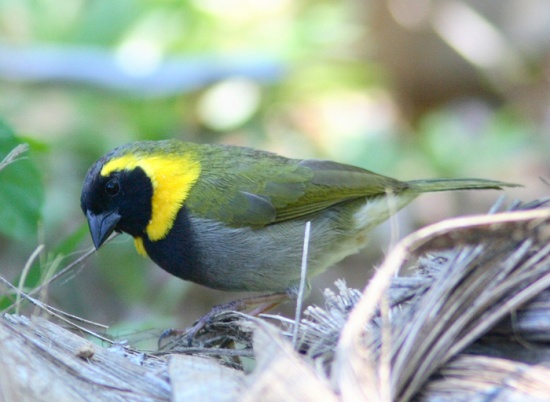- Phonipara canora
Tiaris canorus
Identification
11.5 cm (4½ in)
Olive-green above, grey below, with yellow from throat going back behind auriculars and continuing as a rear supercilium to about the eye.
Male has black face and upper breast
Female has face reddish-brown, yellow is dingier, and breast is unmarked grey.
Distribution
Cuba and Isle of Pines where becoming rare in west and central due to capture for cage bird trade; introduced to New Providence in the Bahamas.
Taxonomy
This is a monotypic species[1].
This species has been placed in genus Tiaris in the past.
Habitat
Lowland dry shrubland, but also forests (mainly edges) to mid elevation.
Behaviour
Usually in flocks except when breeding.
Diet
Their main diet consists of seeds and small fruits.
Breeding
Their nest is a large dome constructed from woven grass; it is lined with softer materials and placed in low branches. The clutch contains 2-3 pale greenish-white eggs, which have purplish spots.
References
- Clements, J. F., T. S. Schulenberg, M. J. Iliff, S. M. Billerman, T. A. Fredericks, B. L. Sullivan, and C. L. Wood. 2019. The eBird/Clements Checklist of Birds of the World: v2019. Downloaded from http://www.birds.cornell.edu/clementschecklist/download/
- Rising, J. D. (2020). Cuban Grassquit (Phonipara canora), version 1.0. In Birds of the World (J. del Hoyo, A. Elliott, J. Sargatal, D. A. Christie, and E. de Juana, Editors). Cornell Lab of Ornithology, Ithaca, NY, USA. https://doi.org/10.2173/bow.cubgra.01
Recommended Citation
- BirdForum Opus contributors. (2024) Cuban Grassquit. In: BirdForum, the forum for wild birds and birding. Retrieved 2 May 2024 from https://www.birdforum.net/opus/Cuban_Grassquit




